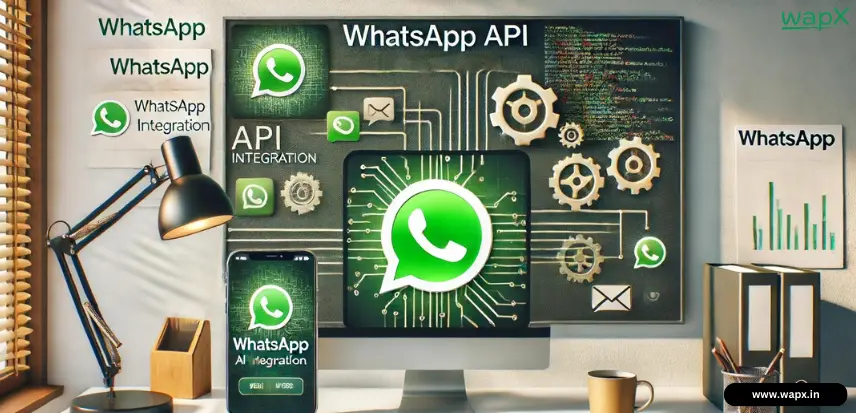WhatsApp API integration In today’s digital age, communication is not just key—it’s the cornerstone of successful business operations. With WhatsApp emerging as a dominant force in global messaging, integrating its API into your business strategy can be a game-changer. This blog serves as your comprehensive guide to navigating the setup process effectively.
Understanding WhatsApp API Integration
What is WhatsApp API?
WhatsApp API (Application Programming Interface) allows businesses to connect their systems directly with WhatsApp, enabling them to send and receive messages programmatically.
Why Integrate WhatsApp API?
Integrating WhatsApp API empowers businesses to leverage the platform for customer service, notifications, and even marketing campaigns. It offers a direct line of communication that is preferred by billions worldwide.
Preparing for Integration
Assessing Business Requirements
Begin by defining your objectives for using WhatsApp API. Determine whether you need it for customer support, notifications, or marketing, as this will guide your integration strategy.
Choosing the Right WhatsApp API Provider
Selecting a reliable WhatsApp API provider is crucial. Consider factors such as pricing, features, scalability, and compliance with WhatsApp policies.
Setting Up Your WhatsApp Business Account
Creating a WhatsApp Business Account
If you haven’t already, start by creating a WhatsApp Business Account. This specialized account is essential for using WhatsApp API for business purposes.
Verifying Your Business
WhatsApp requires businesses to verify their identity to ensure authenticity and compliance with its policies. Follow the verification process diligently.
WhatsApp Sales Funnel: How to Create One Step-by-Step
Exploring WhatsApp API Features
Message Templates and Guidelines
Familiarize yourself with WhatsApp’s message templates and guidelines. These templates ensure your messages comply with WhatsApp’s rules and provide a seamless user experience.
Handling Multimedia Messages
WhatsApp API supports multimedia messages, including images, videos, and documents. Understand how to incorporate these into your communication strategy effectively.
Technical Setup
API Authentication and Access Tokens
Secure your integration by setting up API authentication and obtaining access tokens. This step ensures that only authorized systems can interact with WhatsApp API on behalf of your business.
Webhook Configuration
Configure webhooks to receive real-time notifications about incoming messages, delivery statuses, and other relevant events. Webhooks streamline communication and enhance responsiveness.
Building Your Integration
Using SDKs and Libraries
Utilize WhatsApp API SDKs (Software Development Kits) and libraries provided by your chosen provider. These tools simplify integration by offering pre-built functions and examples.
Implementing Basic Messaging Functions
Start with implementing basic messaging functions, such as sending text messages and receiving replies. Test these functions thoroughly to ensure seamless operation.
Advanced Configuration Options
Adding Chatbots and Automation
Enhance user interaction by incorporating chatbots and automation. Chatbots can handle common queries, provide instant responses, and escalate complex issues to human agents.
Managing Permissions and Security
Put strong security measures in place to safeguard user information and comply with data protection laws. Manage permissions carefully to control who can access WhatsApp API features.
Testing Your Integration
Conducting Unit Tests
Before going live, conduct rigorous unit tests to validate each component of your integration. Test message delivery, response times, and error handling mechanisms.
User Acceptance Testing (UAT)
Engage stakeholders and conduct user acceptance testing (UAT) to gather feedback from real users. Address any usability issues or concerns raised during this phase.
Go Live and Launch
Monitoring and Performance Evaluation
Monitor your integration post-launch to track performance metrics such as message delivery rates, response times, and user engagement. Use these insights to optimize your strategy continuously.
Scaling Your Integration
As your business grows, scale your WhatsApp API integration accordingly. Ensure your infrastructure can handle increased message volumes and user interactions seamlessly.
Best Practices for WhatsApp API Integration
Compliance with WhatsApp Policies
Adhere to WhatsApp’s policies and guidelines at all times to avoid penalties or account restrictions. Stay informed about updates to policy changes.
Optimal Message Timing and Content
Craft messages that are concise, relevant, and timely. To preserve a satisfying user experience, take into account the frequency and substance of communication preferences.
Troubleshooting Common Issues
Debugging API Errors
Develop troubleshooting protocols to address common API errors swiftly. Monitor error logs and implement proactive measures to minimize downtime.
Addressing Delivery Failures
In case of message delivery failures, identify the root cause promptly and communicate transparently with affected users. Implement fallback mechanisms where necessary.
Future Trends in WhatsApp Integration
AI and Machine Learning in Messaging
Expect advancements in AI-driven messaging solutions that enhance personalization and efficiency. Explore AI-powered chatbots to deliver more intuitive user experiences.
Integration with CRM Systems
Integrate WhatsApp API with CRM (Customer Relationship Management) systems to streamline customer interactions and leverage data insights for personalized engagement.
Master WhatsApp Promotional Messages for Business Success
Conclusion
Integrating WhatsApp API into your business strategy opens up new avenues for customer engagement, operational efficiency, and growth. By following this guide, you’re equipped to navigate the setup process confidently and harness the full potential of WhatsApp’s powerful platform.

